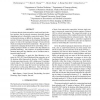Free Online Productivity Tools
i2Speak
i2Symbol
i2OCR
iTex2Img
iWeb2Print
iWeb2Shot
i2Type
iPdf2Split
iPdf2Merge
i2Bopomofo
i2Arabic
i2Style
i2Image
i2PDF
iLatex2Rtf
Sci2ools
111
Voted
ISBI
2011
IEEE
2011
IEEE
Discriminative persistent homology of brain networks
It is known that the brain network has small-world and scalefree topology, but the network structures drastically change depending on how to threshold a connectivity matrix. The exact threshold criterion is difficult to determine. In this paper, instead of trying to determine one fixed optimal threshold, we propose to look at the topological changes of brain network while increasing the threshold continuously . This process of continuously changing threshold level and looking at the resulting topological feature is related to the Rips filtration in persistent homology. The sequence of topological features obtained during the Rips filtration can be visualized and interpreted using barcode. As an illustration, we apply the Rips filtration to construct the FDG-PET based functional brain networks out of 24 attention deficit hyperactivity disorder (ADHD) children, 26 autism spectrum disorder (ASD) children and 11 pediatric control subjects. We visually show the topological evolution ...
| Added | 21 Aug 2011 |
| Updated | 21 Aug 2011 |
| Type | Journal |
| Year | 2011 |
| Where | ISBI |
| Authors | Hyekyoung Lee, Moo K. Chung, Hyejin Kang, Bung-Nyun Kim, Dong Soo Lee |
Comments (0)

